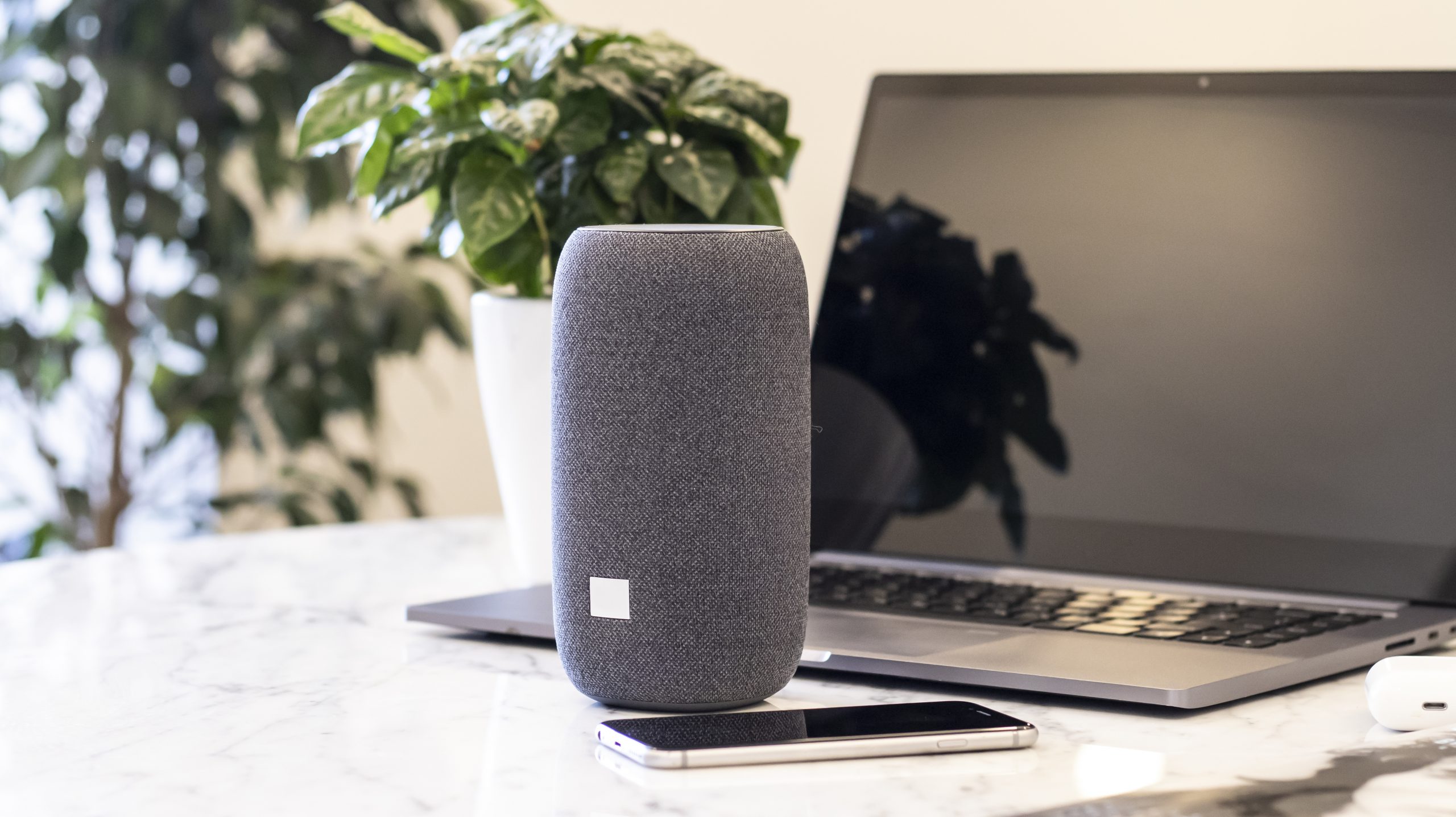How will voice assistants revolutionise working methods?
Until now, voice assistants have prominently been used within private homes with varying degrees of effectiveness, but they are now making their way into the corporate world and could well revolutionise working methods in the future. How do these new smart assistants fit into the company environment? An overview of the various voice-activated devices, their use in companies, their field of application and the prospects they offer for the workplace of the future.

Practical areas of application of voice assistants at work
Voice assistants are voice-controlled connected devices that use artificial intelligence (AI) to perform all sorts of fairly repetitive and time-consuming tasks instead of humans.
The scope of application of voice assistants in companies is fairly broad. In particular, it includes:
- Voice dictation, which is the most widely used element;
- Note-taking (meeting minutes);
- Teamwork;
- Management of employee schedules;
- Customer services;
- IT support services;
- Documentary retrieval: you can ask the voice assistant to display documents on the screen during presentations (financial statements, presentation brochures, etc.).
Voice assistants, therefore, act as an ergonomic asset for the company by minimising the movement of employees.
Overview of various voice assistants in the workplace
As in many areas, the voice assistant market is largely the preserve of GAFAM. Apart from Facebook, whose virtual assistant is still being finalised (and will probably be called Aloha), the other digital giants have all developed their own solutions. These are already widely used in many households and in a number of companies:
- Google Assistant, from the internet giant of the same name, which is activated with the voice command “OK Google”;
- Siri, owned by Apple, can be activated by saying “Hey, Siri”;
- Alexa, owned by e-commerce heavyweight Amazon and used through the Amazon Echo connected speaker, which turns on when you call its name, “Alexa”;
- Cortana, Microsoft’s voice assistant, also unlocks at the mention of its name, “Cortana”.
The Asian digital giants are not to be outdone, as Tencent, Baidu, JD and Alibaba have also developed their own voice assistants.
Phone manufacturers have also jumped on the virtual assistant bandwagon: Samsung has rolled out Bixby and Huawei has launched Celia, which is capable of real-time translation, among other things.
Audio specialists have also naturally developed their own connected speakers, but most of them use the technology of the American giants. This is true of JBL, which uses Google Assistant technology, and Sonos, which uses the Alexa system.
Voice assistants to improve productivity and customer relations
Voice assistants promise to make employees’ tasks easier. In this respect, the benefits of this new technology are already evident in the daily life of companies. However, they are only the beginnings of advances that could well be made at various stages of production and marketing and revolutionise work processes on a much larger scale.
Time savings for staff
Voice assistants can improve productivity by automating repetitive entry-level and low-value tasks. In addition to their role in regulating the space and the environment (adjusting the temperature, turning on the lights, closing the blinds, etc.), these virtual assistants are becoming even more integrated into employees’ actual tasks.
In particular, the voice assistant can replace numerous secretarial tasks (making appointments, booking rooms, defining an itinerary, booking taxis, reserving rooms, etc.). Among other things, it can be used to set reminders for appointments and acts as a voice diary.
It can also be very useful for tracking customer relations, notably by replacing a chatbot or an after-sales service that manages complaints, which are repetitive, time-consuming and not very rewarding tasks, but which are essential for the loyalty and reputation of the company.
The idea is to allow employees to concentrate on the important tasks and to avoid the constant demands that can prevent them from being able to concentrate and adversely affect their performance. The use of Cortana would, in this respect, be particularly welcomed by managers for its ability to integrate with the Microsoft professional office suite (Windows, Office, Teams).
These voice-activated devices will most likely become as much a part of the working environment as the printer, photocopier or rubber stamp are today. Voice assistants will most likely enable full interconnectivity with the entire business ecosystem.
In the long term, it is conceivable that by connecting them to various computer equipment, we will be able to instruct virtual assistants to print a document or even to carry out more or less complex calculations on Excel spreadsheets.
A tool for optimising prospecting
Combined with CRM, voice assistants could, in the future, constitute an additional tool for optimising customer relationship management and prospecting. An algorithm that synthesises all customer data would provide useful information to sales staff for customer research and lead conversion.
They could ask the virtual assistant to provide them with a list of customers to follow up on and the types of services to offer them, or the names of prospects to approach within a given area according to socio-demographic criteria. This speech-to-text functionality could revolutionise canvassing, help close sales and potentially build customer loyalty.
Simplification of the customer experience
In the future, the use of voice assistants will be particularly relevant for companies in the retail and distribution sectors. Combined with artificial intelligence, they will simplify all stages of the customer experience, from the purchasing process with the product search to the conclusion of the transaction, including the order tracking stage.
Already well established in the United States, where it accounts for some 40 billion dollars in turnover each year, V-commerce (voice-commerce) will enable consumers to add items to their baskets using their voice, according to specific criteria (type of product, size, colour, use-by date, etc.). The consumer will be able to use a voice command at every stage of the purchasing process. They can use it to choose the delivery or collection method, or whether or not they wish to take out insurance.
The voice assistant will also make suggestions to the consumer based on their purchase history or an algorithm that includes their favourite product references. They will be able to use it to track the status of their order before delivery.
Finally, voice payment, whose use is currently in its infancy for security reasons, could eventually become established in the same way as phone payment, which has taken some time to become established.
The aim of voice-commerce will be to reduce the effort for the consumer in the purchasing process as much as possible. Its expansion should lead companies to think about integrating voice into their promotional strategies and distribution channels even before considering marketing.
Room for improvement in voice assistants
Despite the appealing claims that voice assistants can improve daily productivity, these new intelligent devices are still a long way from realising their full potential. Some doubts about security still remain, hindering their deployment in the workplace.
Still only limited understanding
The biggest problem for voice assistants’ understanding is picking up surrounding noise. This background noise makes it difficult for the machine to interpret the speech correctly.
The subtleties in voice intonations, words with double meanings or expressions remind us that the machine is (for the moment) not yet capable of fully decoding the complexity of the human brain, made up of connections and convolutions. But it’s working on it…
This complexity is all the more difficult to grasp in the context of professional discussions where the semantic data is sometimes insufficient and too technical (abbreviations or specific vocabulary) to constitute big data. In this respect, the use of machine learning may be a way of improving the voice assistant so that it becomes familiar with the semantic specificities of each sector and each company.
There is also the issue of multi-language comprehension, although the digital giants – led by Google – are making considerable efforts to expand the lexical fields understood by the machine in the majority of the most widely used languages.
A privacy issue?
The spread of voice assistants in companies is not without its share of concerns about data security. At a time when cybersecurity issues are more prevalent than ever and attacks on companies are on the rise, voice assistants must reassure decision-makers for a widespread roll-out in the workplace. They are, for the time being, far short of the mark in this respect, as numerous security flaws have been detected in these devices. This has notably been the case with Cortana and Alexa, in which several instances of recording conversations in the private domain, without the users’ knowledge, have been reported.
The voice-activated device sometimes activates without being prompted and records audio clips at various times of the day. Telephone numbers, credit card numbers, social security numbers and other identifying information can thus be captured by voice assistants during conversations or phone calls. This issue limits the trust placed in these virtual assistants at present. The competent authorities also recommend that the microphone be switched off when the device is not in use.
While these data security problems are of concern in the private sphere, they can prove critical in the professional sphere, where the financial stakes are considerable and issues of competition, patents or commercial strategy are decisive. The manufacturers themselves have no desire to see confidential data sent to the cloud of the American digital giants.
The hacking of this voice technology is still a poorly understood phenomenon, although some start-ups have embarked on cyber-protection by deploying built-in voice assistants that work locally. The system is self-contained and does not transmit to the outside world, thus avoiding any risk of data leakage.
Finally, there is the question of the battery life of voice assistants for uninterrupted use, especially in the event of a long power cut. This is an issue that has not yet been resolved by the manufacturers.
The real expansion of the conversational economy will therefore depend on the ability of voice assistant manufacturers to reassure their business users. To do this, they will have to demonstrate the added value in terms of productivity and customer relations.






